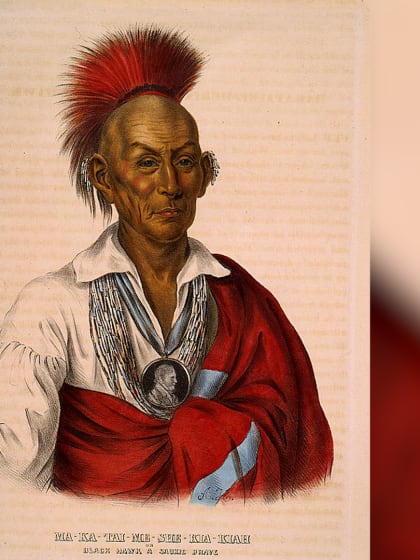

About Black Hawk
Black Hawk, or Mà-ka-tai-me-she-kià-kiàk, was a respected dignitary and proud leader for the Sauk tribe (present-day Sac & Fox). He committed his life to the preservation and protection of his people, his family and the land they were connected to. Today, Black Hawk is still highly revered in the Sac & Fox Tribe, and his legacy carries on nearly 200 years after his death.
Born in 1767 in the village of Saukenuk, near present-day Rock Island, Illinois where the Rock River and Mississippi River meet, he was raised in then the largest village known along the Upper Mississippi, consisting of more than 100 lodges and some 5,000 residents. Growing up, Black Hawk and his siblings lived a life tied to the land, often playing in the cornfields, shooting bows and arrows, and riding horses and canoes.
Black Hawk, or Black Sparrow Hawk in direct translation from the Sauk language, was born into to the tribe's Thunder Clan, the warriors of the tribe related to the rain, the water, the birds and other entities of the Thunder Beings. As a young man, Black Hawk quickly began building a reputation as a war leader, leading battles on behalf of his tribe.
In 1804, Quashquame, a Sauk chief, signed the Treaty of 1804 with agents from the U.S. government, ceding large swaths of Sauk land along the Mississippi River - including Saukenuk. Black Hawk and other tribal members protested the treaty, arguing the chief was not in a position to sign it. That resentment led many Sauk people to side with the British during the War of 1812.
In 1828, an official from the U.S. Bureau for Indian Affairs cited the 1804 Treaty and ordered the Sauk people across the Mississippi River. By this time, much of the Sauk tribespeople followed the leadership of Black Hawk's younger opponent, Keokuk, who was recognized for his moderation and cooperation as more of an ally for the relocation of the Sauk people. Believing the tribe could not possibly resist the United States by force, Keokuk and other likeminded chiefs agreed and moved out of Saukenuk. Black Hawk did not acknowledge these treaties, and the war leader began his campaign to fight against its terms so the tribes could return to their homelands.
In 1831, Black Hawk and his followers crossed back across the Mississippi to reclaim their home in Illinois. Local officials responded by sending troops to remove Black Hawk and the remaining Sauk people from Saukenuk. Surrounded by U.S. troops and vastly outnumbered, Black Hawk signed the "Corn Treaty" under the threat of force, which promised he and the remaining Sauk tribe members would move across the Mississippi River into Iowa and never return.
Despite agreeing to the U.S. government's request, the Sauk continued to face discrimination in Iowa. Settlers violently harassed tribe members, shooting their livestock and disturbing gravesites. The government also failed to provide the tribe with the amount of corn they had promised the Sauk for the winter.
The next year, after a particularly harsh winter, Black Hawk led 400 warriors and their families back across the Mississippi River into Illinois, where they would plant corn for the coming year. The Illinois governor again called upon militia soldiers and the U.S. Army to confront Black Hawk and his followers, even though the majority of these followers were children, women and the elderly who simply sought to live peacefully in their native Saukenuk.
In search of allies, Black Hawk and his band continued up the Rock River, only to be met by uncooperative tribes and skirmishes.
On Aug. 1, under a flag of truce, Black Hawk made an attempt to surrender to the forces aboard the steamboat "Warrior." The soldiers upon the boat opened fire, killing many of his followers. Black Hawk pleaded with his people to retreat with him north, convinced that safety lay among the Ho-Chunk and Ojibwe people. His plea was ignored, and many of the band chose to stand their ground.
On Aug. 2, over an eight-hour period, U.S. forces massacred the remnants of Black Hawk's band with no discrimination for men, women or children. Soldiers killed most of the 400 remaining members of the group, scalping many of their bodies. After this massacre, only a few survivors remained to share their history. Black Hawk's refuge with the Ho Chunk people was brief, and he later surrendered to United States forces.
The U.S. government held Black Hawk in captivity for several months. Officials took Black Hawk on a public tour of the East Coast, showing him and other captured leaders off to crowds as war trophies, dressed in American clothing.
While in custody, Black Hawk met with a government interpreter and dictated his life's story for publication. Published in 1833 as Life of Ma-Ka-Tai-Me-She-Kia-Kiak or Black Hawk, Black Hawk's memoir was one of the first Native American autobiographies published in the United States. Also while in captivity, artist John Wesley Jarvis painted Black Hawk and His Son Whirling Thunder, the only known lifelike image of Black Hawk today that sits in the Gilcrease Museum in Tulsa, Oklahoma.
Among his many life accomplishments, Black Hawk earned the esteemed Eagle Feather - originally awarded to Sauk warriors for their heroics on the battlefield - for his efforts in defending his people. Today, Sac & Fox veterans who have served in the U.S. military are awarded Eagle Feathers by tribal elders or leaders.
After his release from captivity, Black Hawk lived the remainder of his life on tribal lands in Iowa until his death in 1838. An accomplished and proud leader for his people, Black Hawk's legacy is a proud part of the history of the Sac & Fox people.
